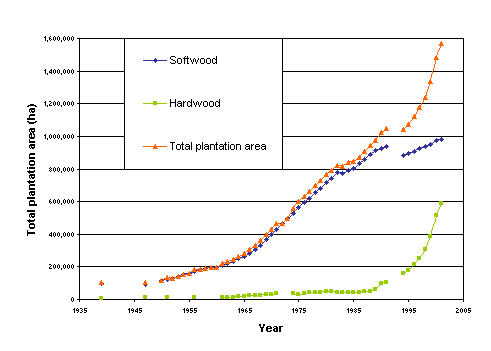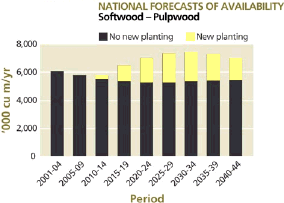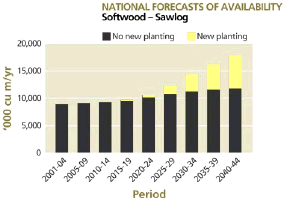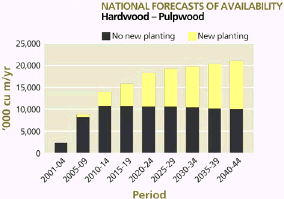

0891-C5
Rodney J. Keenan, Adam Gerrand, Peter Kanowski and Richard Stanton 1
Australia has over 1.5 million ha of plantation forests. Government and industry share a goal of doubling this area by 2020 with most new plantations to be established on previously cleared agricultural land. Plantations currently supply over half of the raw material requirements to the timber industry and provide a range of environmental services and conservation benefits. The ownership and management structure of Australian forest plantations and plantation-based forest industries has changed considerably over the past decade, and plantation growing, processing and marketing sectors are becoming increasingly globalized.
This paper reviews the major forces driving development of forest plantations in Australia and key policy and management issues that need to be considered if plantations are to meet varied expectations of different sectors of the Australian community. This paper presents an overview of these issues based on the invited presentations and panel discussions of a national conference held in Canberra on 20-21 August 2002. The conference considered opportunities for Australia's forest plantations and plantation-based industries in changing global wood markets, alternative and emerging markets for products and environmental services, the potential for plantations to provide environmental benefits, effects of plantations on water yield and quality, and the effects of plantation development on rural and regional communities. Lessons learned from Australia's experience with plantation development are relevant in a wider global context where plantations will be expected to supply a greater proportion of products for and benefits to society that have historically been supplied by native forest.
There are now over 1.5 M ha of plantation forests in Australia (Wood, et al., 2001a). These are located largely in higher rainfall regions (>600 mm/yr) close to the coast, from the wet tropics of north Queensland to the southern extremities of Western Australia and in Tasmania. About 1 M ha are softwood and 0.5 M ha are hardwood (mainly Eucalyptus globulus and E. nitens). The plantation estate has increased by over 0.5 M ha in the last 10 years (Fig. 1). Private investment, from large companies and through schemes for individual investors, has become the dominant source of funds for new plantation establishment. Government and industry have a shared goal of increasing the plantation area to 3 M ha by 2020.
Plantations currently provide over half of the wood to the Australian timber industry and wood production and large-scale plantation-based processing facilities make a significant contribution to many regional economies. Significant increases in plantation wood supply are projected over the next 20 years, particularly of hardwood pulpwood and plantations could be providing 75% of domestic industrial wood by 2010 (Yainshet, et al., 2002). Along with these increases in wood supply from plantations planted forests are increasingly expected supply other environmental benefits such as water quality improvement, dryland salinity mitigation, carbon sequestration and habitat for native plants and animal species.
In light of these developments, a national conference was held in Canberra to discuss future prospects for Australian plantations. Proceedings of a conference with the same theme held in 1989 (Dargavel and Semple 1990) were a reference point for review of recent developments and actions required for plantations to meet the diverse expectations of the Australian community. This paper summarises key issues and considers prospects for Australian plantations in the context of global trends and issues in forest management. We are indebted to presenters at the conference but have not referred to them all in this paper. Most conference papers have now been published (Australian Forestry volume 66). The remainder can be found on the web at www.brs.gov.au/plantationconference).
Past investment in softwood plantations has been relatively profitable over the longer term, with pre-tax real rate of return on capital invested over 30 years of about 6-10%. Reestablishment costs are about A$900/ha (about 6% of final crop revenue) and the decision to replant is well justified. Modest increases in softwood sawlog and pulp availability are expected over the next 10-20 years as these softwood plantations mature (Fig. 2). Substitution of softwood for hardwood in commodity markets such as house framing will continue but producers will need to develop a wider range of products such as plywood and laminated veneer lumber. A strong domestic market for building materials is important to the stability and viability of the softwood plantation-based industry. However, competition from alternative, higher energy and less sustainable materials is increasing and research, innovation, education and training will be critical to the ongoing success of the softwood sector.
Hardwood plantation pulpwood availability will increase rapidly in the next decade from the current level of 2.4 million cubic metres per year to between 11 and 18 million cubic metres a year from 2015 (Fig. 2). This represents an opportunity for expanded local pulp and paper manufacture and export of hardwood chips with China the main potential market for increased sales. Hardwood sawlog availability will not increase substantially until after 2015.
There is a need to develop other products, particularly using lower grade wood. These could include activated carbon, wood composites, eucalyptus oil, chemically modified wood and bioenergy.
Certification is an increasingly important issue in the marketplace and several Australian plantation growers are pursuing independent third-party certification. The equivalence of different systems and their recognition by the international market needs consideration by groups developing certification standards.
Water is an important resource for irrigated agriculture in regional Australia. Allocation and use of water is an important public policy discussion and water use by plantations is an increasing part of this debate (Nambiar, et al., 2001). Increased water in the landscape is also the cause of two of Australia's most significant environmental problems. Large areas of agricultural Australia were previously covered with forest vegetation, often with a woodland structure (20-50% canopy cover). Grazing and cropping land uses replacing them intercept and use less water and are hydrologically more `leaky'. Movement of water mobilises salt stored in the landscape, increasing stream salinity and raised water tables is resulting in areas affected by dry-land salinity, Plantation establishment, along with other forms of woody revegetation, are a potentially important salinity mitigation option. However, greater water use by tree crops means that plantation development could reduce river flows and recharge to groundwater (Fig. 3). To mitigate salinity, plantations will have to be carefully targeted to those regions and sections of catchments where salt is present and avoid areas that supply freshwater downstream (Stirzaker et al. 2002).
Salinity is more of a problem in lower rainfall areas (<800 mm) and impacts on water yield there will be lower. Therefore, it is desirable to concentrate plantation establishment in those regions. However, this is bringing new management challenges. Plantations have not been traditionally grown for wood production in these regions. Tree survival and growth rates are lower, there is limited plantation development infrastructure and few processing plants. Unless land and management costs are significantly lower, financial returns from plantations are likely to be relatively unattractive to investors. Lower returns could be supplemented by payments for environmental benefits. Australia has been a leader in developing market-based mechanisms for carbon trading (Keenan, et al., 2000). Similar arrangements could apply to other services such as salinity mitigation or biodiversity conservation. These mechanisms may make less productive areas more profitable for plantation development and encourage appropriate species and planting designs that provide a broader range of environmental benefits (van Bueren, et al., 2001).
Until the 1990's, most new plantations were established on areas converted from native forests. Replacement of native forests with exotic conifers provoked considerable and increasing adverse community reaction from the early 1970s (Routley and Routley 1972). Policies prohibiting conversion of native forest to plantations have now been implemented in all mainland states and territories. With appropriate design, new plantations can increase landscape diversity and habitat quality for wildlife (Keenan, et al., 1999). Retention of remnant native individual trees or patches within a plantation can have considerable biodiversity value (Klomp, et al., 2002). Maintaining a mosaic of plantation age classes restoring native species at the time of plantation establishment and managing retained native vegetation in water courses, ridges or steep areas can increase the habitat value of plantation areas. Species mixtures can increase structural and functional diversity and potentially increase overall production. Leaving thinning and pruning waste to rot can provide habitat for invertebrates.
There continues to be considerable appreciation of trees in the Australian landscape. However, the notion that `any tree anywhere is a good thing' is increasingly questioned (Alexandra, et al., 2002). Plantation establishment on agricultural lands is rapidly changing the visual outlook of some rural landscapes and communities are sometimes reacting negatively to this altered appearance. Communities are concerned about conversion of native forest to plantations, loss of traditional rural enterprises, use of chemicals and their possible effects on native animals and waterways, impacts on roads and increased truck traffic once large-scale harvesting commences and impacts (real or perceived) on social structures and community networks.
More complex and varied plantation designs can be used that more effectively integrate timber production with existing agricultural pursuits, modifying impacts of plantations on agricultural production and landscape aesthetics. While there have been some significant research innovations in this regard, such designs and systems are not yet widely implemented in Australia.
Plantation industries and government need to work closely with communities to address their concerns. Formal planning appeal mechanisms may not always be an appropriate way to resolve disputes and informal communication arrangements seem to be more successful (Schirmer and Tonts, 2002b). Approaches to community engagement include: information dissemination and communication and consultation strategies with local governments, communities and owners of neighbouring properties.
After more than a century developing plantation forest resources, Australian experience can serve as a guide to those countries wishing to expand their plantation forest estates, but we also have much to learn from experiences in other countries. We should keep in mind that commercial, political, social and economic circumstances are changing rapidly and flexibility is needed in determining policies and future goals.
The pattern of utilisation of forest resources in Australia reflects that of many other nations outside Europe. There was initially a strong reliance on extraction of wood products from natural forests. This increased following World War II to provide cheap wood for post-war reconstruction and for a rapidly expanding population. Post-war policy initiatives enabled State agencies to expand softwood plantations and these have provided a resource base for development of a world-scale processing sector (Gerrand, et al., 2002). They have also provided governments with a greater degree of flexibility with regard to the degree of utilisation of native hardwood forests for wood production without increasing our reliance on imported wood products. More recent financial deregulation and tax incentives have provided the environment for expansion of the hardwood plantation estate.
Expansion of softwood plantations was largely achieved through clearing of native forests with associated environmental impacts that were increasingly criticised during the 1970s and 1980s. Whether an alternative development path would have produced better environmental outcomes is a matter for debate. Many involved would argue that converting native forests was the most efficient investment of government funds. Restricting plantation development in that era to cleared agricultural land would probably have resulted in a considerably smaller and more fragmented plantation estate with a lower production capacity.
Our more recent experience is that policies to restrict clearing of native forests for plantations can be successful. Government and private plantation developers in most states are now restricted to using cleared agricultural land (Commonwealth of Australia, 1992). In Tasmania, controls are in place under the Regional Forest Agreement with the Commonwealth Government that prohibit the conversion of rare or threatened forest ecosystems and habitats to plantations.
Developing countries contemplating significant plantation expansion are faced with similar options to those used at different times in Australia: to convert native forest or to convert lower quality agricultural land. Australia's experience suggests that either course will present significant technical, social and environmental challenges.
Conversion of native forests to plantations posed numerous technical challenges that were overcome through investment in research and development. This provided significant production benefits through matching species to sites, development of new genotypes with better growth and wood properties and adoption of more effective site preparation and fertilisation regimes. Expansion of plantations on cleared agricultural land has posed other technical challenges in determining appropriate fertilisation requirements and site selection and in designing plantation production systems that can be integrated with other forms of agricultural production.
To achieve desired environmental benefits, more plantations in the future will be established on less favourable sites using non-traditional species. Despite being the home of Eucalyptus, limited areas of eucalypt plantations have been established in Australia until relatively recently. Over the past 15 years, eucalypt species have overtaken softwoods in areas planted annually. Research evaluating a wider range of eucalypt species, especially those suitable for lower rainfall environments (Harwood, et al., 2002) is likely to be of significant interest to countries where similar sites represent opportunities for plantation expansion. Conversely, Australia has much to learn from the developing worlds of Africa, Latin America and Asia in the deployment of eucalypt resources in plantations and integration of commercial forest and agricultural production.
Planting trees to mitigate salinity will require careful design and planning to avoid impacts on water yield while achieving salinity mitigation and water quality improvement. The current debate in Australia over allocation of water resources is focusing more attention on the way in which plantations established on currently cleared land affect water availability in catchments. More is now known about these impacts and options for minimising impacts. Water use by plantations has been of concern for some time in places with a similar climate to Australia, such as South Africa (Department of Water Affairs and Forestry, 2000) and parts of India, and Australian scientists and policy makers can benefit from the scientific analyses and policy options to address issues of plantations and water in those countries.
Market factors will be critical in determining the future success of plantation development. Globally, future increases in demand for wood are predicted to be met largely by forest plantations (FAO, 2001). Australian experiences conform to this trend. Past performance suggests that softwood plantations in Australia will continue to be profitable investments and make substantial contributions to regional economies and local communities, although softwood processors will face increased international competition. Profitability and markets for hardwood plantations, grown for solid wood or pulpwood, are currently less certain. Markets for lower quality wood will remain a challenge and development of options beyond pulpwood such as biomass energy generation, composite products or activated charcoal will be needed to ensure the economic viability of plantations grown for solid wood.
Australian plantation expansion is now being driven by private finance, with an increasing complexity of ownership arrangements such as joint ventures between government and private investors. Corporatisation of state plantation management and sale to private owners has proceeded rapidly in the past decade (Schirmer and Kanowski, 2002) motivated by the desire to reduce public expenditure and for greater efficiency and profitability. This is consistent with global trends (Garforth, et al., 2002) and corporate involvement in plantation ownership and management is likely to increase in the future in Australia and elsewhere.
Impacts (real or perceived) of plantation development on rural communities have been observed for some time and have increased in the last decade as the plantation estate has expanded onto cleared agricultural land in a more substantial way. Most plantation proponents are more aware of, and responsive to, community concerns about the impacts of plantations. Consideration of potential social and environmental impacts at an early stage of plantation development is vital in facilitating community acceptance of plantation development.
Pro-active land-use planning before plantation establishment in consultation with communities can result in design and implementation of plantations to deliver a commercially viable plantation estate that also meets community expectations and minimises environmental impacts (Kanowski, 2003). However, there is likely to be continuing tension between the desire of the commercial world for highly efficient, large-scale, globally competitive, plantation-based industries and the expectations of many stakeholders for smaller-scale plantations that are integrated with traditional farming activities and meet land rehabilitation, water quality or conservation objectives.
Given the rapidly changing environment, it may be unwise to speculate on the nature of the plantation estate, the timber industry, community attitudes or the issues facing plantation managers in 10 or 20 years time. To echo the words of Dargavel (1990b; 2002), the need for public examination, informed debate and critical participation remains an important component of the forest development process. Much still remains to be done to ensure that plantations deliver economic, environmental and social benefits for the Australian and the global community.
We thank all the sponsors, presenters, chairs and delegates at the conference, Prospects for Australia's forest plantations 2002, for their valuable contributions to the ongoing debate regarding the role of forest plantations in Australia.
Commonwealth of Australia (1992) National forest policy statement. A new focus for Australia's forests. Commonwealth of Australia.
Dargavel, J. (1990) Creating the prospects for Australian plantations. In 'Prospects for Australian Forest Plantations'. (Ed. Semple, N.) pp. 437-439. Centre for Resource and Environmental Studies, ANU: Canberra.
Department of Water Affairs and Forestry (2000) 'Water use and conservation.' Department of Water Affairs and Forestry, Republic of South Africa.
FAO (2001) 'State of the world's forests:2000.' FAO, Rome.
Ferguson, I.F., Spencer, R., Wood, M. and Gerrand, A. (2002) Australian supply and demand for plantation products. In: Gerrand, A.M. (Ed.) Proceedings of the Prospects for Australian Forest Plantations 2002 conference. Bureau of Rural Sciences. Canberra, Australia. pp. pp 29-40.
Garforth, M., Landell-Mills, N. and Mayers, J. (2002) Changing Ownership and Management of State Forest Plantations. Changing ownership and management of State forest plantations: issues, approaches, implicationsKirstenbosch Botanical Gardens, South Africa.
Gerrand, A.M., Miller, R., Catton, C. and Joseline, A. (2002) 'Incentives for forest plantations in Australia. Country report as part of a 9 country study presented to FAO Asia-Pacific Forestry Commission.' FAO Asia-Pacific Forestry Commission, Ulan Battaar, Mongolia.
Harwood, C. and Bush, D. (2002) 'Breeding trees for the low rainfall regions of southern Australia.' RIRDC.
Kanowski, P. (2003) Challenges to enhancing the contributions of planted forests to sustainable forest management. The role of planted forestsWellington, New Zealand.
Keenan, R.J., Grist, P., Hansard, A. and Grant, A. (2000) Implications of the Kyoto Protocol for Plantation Development. Paper to the FAO International Conference on Timber Plantation DevelopmentManila, Philippines.
Keenan, R.J., Lamb, D., Parrotta, J. and Kikkawa, J. (1999) Ecosystem management in tropical timber plantations: satisfying economic, conservation and social objectives. Journal of Sustainable Forestry 9, 117-134.
Klomp, N. and Grabham, C. (2002) 'A comparison of the avifaunal diversity on native hardwood plantations and pastureland in north-east Victoria in 1999-2001.' Charles Sturt University, Johnsone Centre Report No. 164, Albury.
Nambiar, E.K.S. and Brown, A.G. (Eds) (2001) Plantations, Farm Forestry and water: Proceedings of a National Workshop A report for the Joint Venture Agroforestry Program. RIRDC Publication No. 01/20, Canberra: Melbourne.
Schirmer, J. and Kanowski, P. (2002) Changing Ownership and Management of State Forest Plantations: Australia's experience. Changing ownership and management of State forest plantations: issues, approaches, implicationsKirstenbosch Botanical Gardens, South Africa. pp. 38.
Stirzaker, R., Vertessy, R. and Sarre, A. (2002) Trees, Water and Salt: An Australian Guide to Using Trees for Healthy Catchments and Productive Farms. Joint Venture Agroforestry Program: Canberra, Australia.
van Bueren, M., Binning, C., Baker, B., Meharg, S., Kearns, A. and Cork, S. (2001) 'Making farm forestry pay.' Joint Venture Agroforestry Program, Rural Industries Research and Development Corporation, Canberra.
Vertessy, R.A. and Bessard, Y. (1999) Anticipating the negative hydrological effects of plantation expansion: results from a GIS-based analysis on the Murrimbidgee Basin. In 'Forest Management for Water Quality and Quantity. CRC Catchment Hydrology, Report No. 99/6'. (Eds Croke, J. and Lane, P.) pp. 1-5. Cooperative Research Centre for Catchment Hydrology: Melbourne.
Wood, M., Stephens, N.C., Allison, B.K. and Howell, C.I. (2001) 'Plantations of Australia 2001 - A report from the National Plantation Inventory and the National Farm Forestry Inventory.' National Forest Inventory, Bureau of Rural Sciences, Canberra, Canberra.
Yainshet, A., Nelson, R. and Love, G. (2002) 'Rising domestic plantation wood supplies - Implications for Australian production and use of forest products.' ABARE, ABARE Current Issues 02.7, Canberra.
Figure 1: Plantation forest area in Australia by species group since 1935. (from Gerrand et. al. 2003 - data were derived from various sources.)

Figure 2. Forecasts of wood availability from the Australian plantation estate to 2044 assuming either (i) no new planting or (ii) possible new plantings according to estimation undertaken by the Bureau of Rural Sciences (source Ferguson et al. 2002).




Figure 3. Mean annual runoff curves for different land covers, after Vertessy and Bessard (1999).

1 Bureau of Rural Sciences, Dept. of Agriculture, Fisheries and Forestry, P.O. Box 858,Canberra, ACT, 2601, Australia. [email protected]